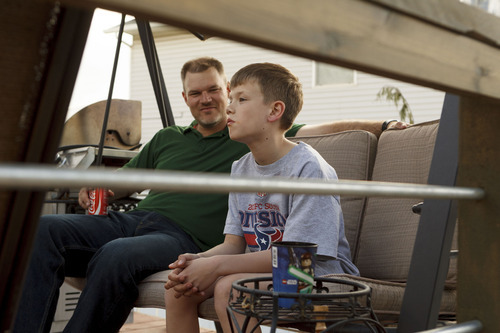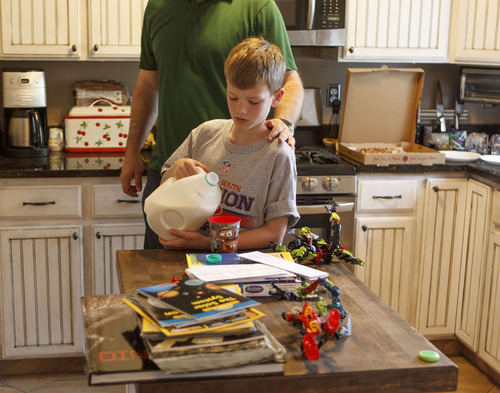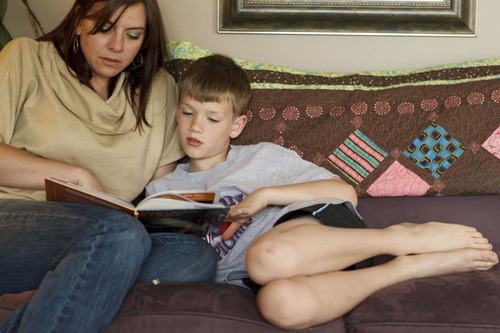This is an archived article that was published on sltrib.com in 2012, and information in the article may be outdated. It is provided only for personal research purposes and may not be reprinted.
At age 9, Jack Wolfinger is on his fifth dinosaur encyclopedia. He can explain the lineage of raptors but doesn't play with other kids at recess. He's articulate but struggles to write down his thoughts or the answers to a test.
Since kindergarten, teachers have wondered whether he might have autism or Asperger's syndrome — disorders that federal researchers recently claimed are skyrocketing in Utah and across the country.
Salt Lake City neuropsychologist Sam Goldstein takes a more nuanced view of Jack. Some of his behavior falls within the autism range, but not all, Goldstein decided after assessing him. He rejected an autism diagnosis, said Jack's mom, Lacey Wolfinger.
Goldstein has a similar skepticism for recent findings that 1 in 47 children in Utah and 1 in 88 children in the nation fall on the autism spectrum. The study by the Centers for Disease Control and Prevention, he believes, is "extremely flawed."
"The incidence of autism across the U.S. will vary based on knowledge of the community, professionals in the community who have an interest in the condition," he said.
The mystery about the causes of autism has been joined by a new puzzle: are dramatic increases in rates truly real?
Critics question whether increased awareness accounts for the jump, or the expanded definition of autism spectrum disorders. Children may be being misdiagnosed, or parents may be seeking the diagnosis to access services.
Some experts say a high number of children may have always had such behaviors but were described by other labels or not seen as disabled. Others suggest the high rates prove educators and health care providers are doing their jobs well, and kids are getting the help they need even earlier.
"The explosion and the continuing increase suggest that autism is a very hot diagnosis," said Sandra Harris, executive director of Douglass Developmental Disabilities Center at Rutgers in New Jersey. "Someone drew the parallel between that and [Attention Deficit Hyperactivity Disorder], which was the diagnosis of the '90s. Autism spectrum disorders seem to be the diagnosis of the new century."
—
Critiquing the study • The recent study by the CDC focused on samples from 14 areas, including 2,123 children from a Wasatch Front community. Researchers examined medical records for 8-year-olds and, where they had access, school records.
The results were intended to be a snapshot, not statewide or nationwide judgments, said epidemiologist Jon Baio, the study's lead author.
Differing rates may be explained in part by what records were available. In the Alabama area found to have the lowest prevalence — 1 in 210 — researchers couldn't access school records. And poverty can affect whether a family seeks advice from a doctor about a child's behavior.
"You might really rely on those educational evaluations and not have the resources to go to a medical clinic," said Laura Klinger, director of the TEACCH autism program at the University of North Carolina.
And Goldstein is right about resources playing a role, Baio said.
"The amount of services in a community can certainly affect our prevalence estimates," said Baio. "Because we're not going and screening every child in the population. We're looking at children who are being served for a variety of behavioral conditions."
But Judith Zimmerman, an assistant professor at the University of Utah's Department of Psychiatry and principal investigator of the study in Utah, remains confident in the CDC's results for the Wasatch Front children, the study's smallest sample.
She points to the quality of Utah's data from health and education records and the outside experts who reviewed the work. Of the kids the study identified as having autism, about 30 percent did not have a diagnosis or classification at school.
"Other studies that are done well are finding similar things," she added, referring to high rates in places such as South Korea, where a study released in 2011 showed a rate of 1 in 38 children with autism.
Rob Horner, a professor of special education at the University of Oregon, would like to see a study of far more children, drawn from more areas of Utah. "Before the state of Utah leaps into a panic mode they need to replicate this with another group of students," he said.
More research is under way, including a look at 25,000 Utah children who were ages 4 and 8 in 2010. Another CDC study will examine whether states with higher rates and increases have a different level of services available.
"I hesitate to say it's a positive thing that so many children were identified in Utah," said Baio, the CDC researcher. "But in some ways it does reflect that children in that community have better access to programs, services, to resources that are serving children with autism."
—
Exploring the jump • Schools added autism as a qualification for special education services almost 20 years ago. Typically, growth in a new category slows after about five years. With autism, that hasn't happened.
In 2004, Utah clarified that autism includes Asperger's syndrome, often seen in kids of high intelligence. Some question whether such expansions to the definition have driven the rate to spike.
Or some children may be moving between categories, a point researchers debate. National data from the U.S. Department of Education show the number of intellectually disabled kids between age 6 and 11 has dropped, from 238,707 in 1999 to 144,083 in 2010. During that period, autism grew from 43,517 to 199,437.
Twenty years ago, it was considered an "early" diagnosis if a child was identified at age 4 or 5. Now clinicians can sometimes recognize symptoms as early as 15 months, such as a child who does not turn when his name is called or point when she is excited.
And some parents may be seeking the diagnosis.
About 15 years ago, Klinger remembers, a mother at an Alabama autism clinic said she'd rather have learned her child had cancer than autism.
"Autism was such a terrible, hopeless diagnosis 15 years ago," said Klinger. "I think there's a shift where families are saying, 'That label will help my child get the services they need.' "
Harris at Rutgers has seen the success of the autism community. "It is an unfortunate reality that kids on the spectrum get more resources as a group than do kids with other diagnoses," Harris said. "Parents of kids on the [autism] spectrum have been front and center pursuing the issue."
But Glenna Gallo, director of special education at the Utah State Office of Education, says a child's needs, not the specific disability, dictate the level of services.
Still, a new state pilot will soon funnel several million dollars toward kids with autism in Utah, which parents hailed as a triumph at the Legislature this spring.
—
Seeking help •For many parents, the label matters less than getting their child the help he needs. Lacey Wolfinger has requested an evaluation for special-education services for Jack, which will take place next school year.
She worries his love of learning will be extinguished by the frustrations he's experiencing at school as he tries to perform like other kids.
"If he was disrupting class ... they would have done something this year," she said. "Instead he doesn't want to make a stink, he doesn't want to ask for the help he needs, [so] he slips right through."
Nathan Skeen is newer to the world of autism and disabilities, having just received a diagnosis for his child this spring.
When his son was about 16 months old, the family noticed he wasn't starting to talk like other kids his age. Just before the boy turned 2, a doctor told the parents their son likely has Asperger's or a pervasive developmental disorder.
Skeen is struggling to pinpoint the best path to help his son. At times, he and his wife have felt overwhelmed by what they need to do.
"We've discussed whether it is the right diagnosis," the father said. "I don't have a big reason to doubt it, but you just don't know. I think kids in Utah may be overdiagnosed perhaps more than anywhere else. I don't know how else you explain the numbers."
Want to learn more about autism in Utah?
O Go to the Department of Health website › http://www.health.utah.gov/cshcn/autism.html.



















